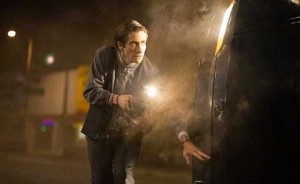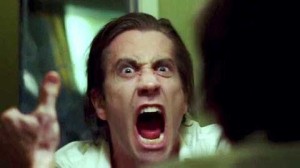
Kevin Kavanaugh is no stranger to using cities as characters in the films on which he works. This was especially true of his work creating Gotham City for director Christopher Nolan in two Batman installments. Kavanaugh was nominated by the Art Directors Guild as a production designer in the fantasy film category for The Dark Knight Rises and as a supervising art director, as part of the winning team in the same ADG category, for The Dark Knight. Gotham, like the Emerald City, is a mythical cityscape, albeit a dystopian one. What happens when a city, as one of the lead characters in the film, is real?
In veteran screenwriter Dan Gilroy‘s directorial debut, Nightcrawler, the city is Los Angeles, which tends to be as self-mythologizing as Oz. Here, the Pueblo of Angels is a place where the mercury-lit nights seem to last as long as they do in the arctic circle. Kavanaugh cites for inspiration other films where L.A. is the co-star, like Robert Altman‘s update of Raymond Chandler‘s The Long Goodbye (1973). “You enjoy the textures and the nuances,” Kavanaugh said of the landscape. The film also recalls Collateral (2004), with hitman Tom Cruise in the back of a taxi prowling another of SoCal’s perpetual nights.
Indeed, the visual imprint of that film’s director, Michael Mann, even came up during one of the many location scouts Kavanaugh undertook to help define Nightcrawler’s look. A key sequence involving the murder of a seemingly well-heeled couple takes place in a house described as being in the North Valley – around the confluence of Granada Hills, Northridge and Chatsworth.
“As soon as I saw the house, I said, ‘This is it,'” Kavanaugh recounted, of the eventual location. The sleek lines and large panes of glass, the halo of bright light cast by the dwelling at night all vibed in a “Michael Mann kind of way.”
Though the house was not only different than what the director had written – he was imagining one of the valley’s too-many “McMansions” as the scene of the crime – it also wasn’t strictly located in the neighborhood where the murders were said to take place.
 And while that’s standard operating procedure for most films – where locations will usually be faked and doubled in cities where the production rebates are highest – it was unusual for Nightcrawler, which was not only set in L.A., but was actually filmed there.
And while that’s standard operating procedure for most films – where locations will usually be faked and doubled in cities where the production rebates are highest – it was unusual for Nightcrawler, which was not only set in L.A., but was actually filmed there.
In part, director Gilroy wanted to retain the psychic energy of his script, with literal races along canyons and freeways as Jake Gyllenhaal’s character, Lou Bloom, tries to get to crime scenes, sometimes with deadly consequences, ahead of his rivals in the freelance footage biz of crime reporting. Part of that energy came from a certain juxtaposition. “Dan showed me an image of downtown L.A. from a satellite,” Kavanaugh recounted. “Forty miles out and it’s completely black.”
“[Bloom] is kind of a coyote,” he continued, and that sense of coming in from the wild edges, to feed as it were, was part of that interplay of topography and storyline.
Kavanaugh collaborated with both his longstanding art decorator, Naaman Marshall, and set decorator, Meg Everist, as well as with cinematographer Robert Elswit – who Gilroy described as “a magician when it comes to capturing light” – in allowing the city its full “characterhood” in the story. He was also grateful for the chance to work without having to go anywhere.
“We all started before we had kids,” he said of Marshall and Everist. “It’s really kind of the family I work with.” And while they would also bring their real families with them on location, there was a chance to go to birthday parties, and all the rest, from the comforts of home.
Kavanaugh, though, is good at making other locales very home-like. His usual scouting technique is to try and find a neighborhood he likes. Then he’ll cold scout it and begin ringing doorbells. “You’d be surprised at how many people open that door,” he said. “And you never know what’s behind it.” When he finds something he likes, he becomes a “kind of a salesman” to lobby for its use as a location. In the case of the house used for the murder scene, the “people were kind enough to let us hang out there after dinner.”
Prepping to be back out of town and on location knocking on doors when he spoke with us, Kavanaugh was glad to have worked in the town where he grew up, and able to bring a little of his “own version of what L.A. is and where the roads take me,” to the screen.





